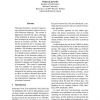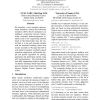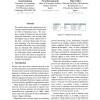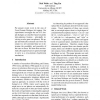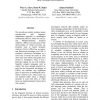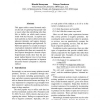COLING
2008
14 years 1 months ago
2008
This paper describes the design and evaluation of an extractive summarizer for educational science content called COGENT. COGENT extends MEAD based on strategies elicited from an ...
COLING
2008
14 years 1 months ago
2008
This paper presents a general platform, namely synchronous tree sequence substitution grammar (STSSG), for the grammar comparison study in Translational Equivalence Modeling (TEM)...
COLING
2008
14 years 1 months ago
2008
Addressing the task of acquiring semantic relations between events from a large corpus, we first argue the complementarity between the pattern-based relation-oriented approach and...
COLING
2008
14 years 1 months ago
2008
This paper describes a system for processing economic documents written in the ancient Sumerian language. The system is application-oriented and takes advantage of the simplicity ...
COLING
2008
14 years 1 months ago
2008
We introduce a novel semantic representation formalism, Almost Flat Functional semantics (AFF), which is designed as an intelligent compromise between linguistically motivated pre...
COLING
2008
14 years 1 months ago
2008
We conduct large-scale experiments to investigate optimal features for classification of verbs in biomedical texts. We introduce a range of feature sets and associated extraction ...
COLING
2008
14 years 1 months ago
2008
We present recent work in the area of Cross-Domain Dialogue Act tagging. Our experiments investigate the use of a simple dialogue act classifier based on purely intra-utterance fe...
COLING
2008
14 years 1 months ago
2008
We describe an entirely statistics-based, unsupervised, and languageindependent approach to multilingual information retrieval, which we call Latent Morpho-Semantic Analysis (LMSA...
COLING
2008
14 years 1 months ago
2008
This paper studies three techniques that improve the quality of N-best hypotheses through additional regeneration process. Unlike the multi-system consensus approach where multipl...
COLING
2008
14 years 1 months ago
2008
This paper tackles textual demand analysis, the task of capturing what people want or need, rather than identifying what they like or dislike, on which much conventional work has ...

